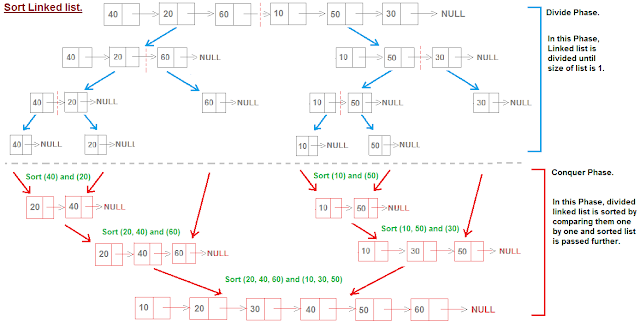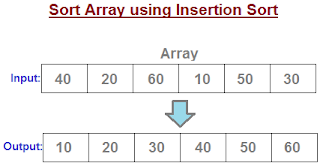Related questions: Sort Linked List using Merge Sort, Given a Linked list, Sort it using Merge Sort Algorithm.
Merge sort is preferred algorithm for sorting a linked list, lets see why,
The way linked list is structured which doesn't allow random access makes some other algorithms like Quicksort perform poorly, So Merge sort is often preferred algorithm for sorting linked list.
For sorting Linked list, we can use any algorithm but the most suitable algorithm is Merge Sort.
Why is merge sort preferred over quick sort for sorting linked lists?
As Singly Linked list can be accessed in only one direction and cannot be accessed randomly, Quick sort will not be well suitable here.
Quick sort requires access to elements in both direction for swapping and doing such operation in Linked list is not as easy as working with Arrays.
Starting from the end and moving backward is usually expensive operation in Singly linked list.
So Quick sort is well suited for arrays and not linked list.
Merge sort is a divide and conquer algorithm in which need of Random access to elements is less.
So Merge Sort can be used for sorting Linked list.
How Merge Sort works
Merge sort is preferred algorithm for sorting a linked list, lets see why,
The way linked list is structured which doesn't allow random access makes some other algorithms like Quicksort perform poorly, So Merge sort is often preferred algorithm for sorting linked list.
Lets understand what is the input and the expected output.
Algorithm (We will use Merge Sort for sorting Linked list.)For sorting Linked list, we can use any algorithm but the most suitable algorithm is Merge Sort.
Why is merge sort preferred over quick sort for sorting linked lists?
As Singly Linked list can be accessed in only one direction and cannot be accessed randomly, Quick sort will not be well suitable here.
Quick sort requires access to elements in both direction for swapping and doing such operation in Linked list is not as easy as working with Arrays.
Starting from the end and moving backward is usually expensive operation in Singly linked list.
So Quick sort is well suited for arrays and not linked list.
Merge sort is a divide and conquer algorithm in which need of Random access to elements is less.
So Merge Sort can be used for sorting Linked list.
How Merge Sort works
- Merge Sort works by breaking the linked list(or Array) into 2 equal parts say Left half and Right half.
- Again break 2 list that we got in Step 1 in two equal parts each.
- Repeat above steps until only 1 element remains in Linked list (or Array) because list with only 1 element is always sorted.
- So in each step we are breaking the list in Left half and Right half.
- When complete list is divided and contains only Single element in Left and Right half each, Start comparing and sorting each Left and Right half, So that portion of Linked list will be sorted.
- Repeat Step 5 for all the remaining Left and Right half and complete linked list will be sorted.
It works on divide and conquer technique. Time complexity is O(N log N).Lets understand with the help of below example.
Sorting Linked list using Merge sort in Java. (Recursive Approach)
package linkedlist.singly;
public class SortLinkedList {
Node startNode;
public static void main(String[] args) {
new SortLinkedList();
}
public SortLinkedList() {
Node node1 = new Node(10);
Node node2 = new Node(1);
Node node3 = new Node(-2);
Node node4 = new Node(8);
Node node5 = new Node(9);
Node node6 = new Node(10);
Node node7 = new Node(1);
node1.setNext(node2);
node2.setNext(node3);
node3.setNext(node4);
node4.setNext(node5);
node5.setNext(node6);
node6.setNext(node7);
startNode = node1;
Node sortedStartNode = mergeSortLinkList(startNode);
printLinkList(sortedStartNode);
}
private Node mergeSortLinkList(Node startNode){
//Break the list until list is null or only 1 element is present in List.
if(startNode==null || startNode.getNext()==null){
return startNode;
}
//Break the linklist into 2 list.
//Finding Middle node and then breaking the Linled list in 2 parts.
//Now 2 list are, 1st list from start to middle and 2nd list from middle+1 to last.
Node middle = getMiddle(startNode);
Node nextOfMiddle = middle.getNext();
middle.setNext(null);
//Again breaking the List until there is only 1 element in each list.
Node left = mergeSortLinkList(startNode);
Node right = mergeSortLinkList(nextOfMiddle);
//Once complete list is divided and contains only single element,
//Start merging left and right half by sorting them and passing Sorted list further.
Node sortedList = mergeTwoListRecursive(left, right);
return sortedList;
}
//Recursive Approach for Merging Two Sorted List
private Node mergeTwoListRecursive(Node leftStart, Node rightStart){
if(leftStart==null)
return rightStart;
if(rightStart==null)
return leftStart;
Node temp=null;
if(leftStart.getData() < rightStart.getData()){
temp=leftStart;
temp.setNext(mergeTwoListRecursive(leftStart.getNext(), rightStart));
}else{
temp=rightStart;
temp.setNext(mergeTwoListRecursive(leftStart, rightStart.getNext()));
}
return temp;
}
private Node getMiddle(Node startNode) {
if(startNode==null){
return startNode;
}
Node pointer1=startNode;
Node pointer2=startNode;
while(pointer2!=null && pointer2.getNext()!=null && pointer2.getNext().getNext()!=null){
pointer1 = pointer1.getNext();
pointer2 = pointer2.getNext().getNext();
}
return pointer1;
}
private void printLinkList(Node startNode) {
Node temp = startNode;
while(temp!=null){
System.out.print(temp.getData() + " ");
temp = temp.getNext();
}
}
}
Sorting Linked list using Merge sort in Java. (Iterative Approach)
package linkedlist.singly;
public class SortLinkedList {
Node startNode;
public static void main(String[] args) {
new SortLinkedList();
}
public SortLinkedList() {
Node node1 = new Node(10);
Node node2 = new Node(1);
Node node3 = new Node(-2);
Node node4 = new Node(8);
Node node5 = new Node(9);
Node node6 = new Node(10);
Node node7 = new Node(1);
node1.setNext(node2);
node2.setNext(node3);
node3.setNext(node4);
node4.setNext(node5);
node5.setNext(node6);
node6.setNext(node7);
startNode = node1;
Node sortedStartNode = mergeSortLinkList(startNode);
printLinkList(sortedStartNode);
}
private Node mergeSortLinkList(Node startNode){
//Break the list until list is null or only 1 element is present in List.
if(startNode==null || startNode.getNext()==null){
return startNode;
}
//Break the linklist into 2 list.
//Finding Middle node and then breaking the Linled list in 2 parts.
//Now 2 list are, 1st list from start to middle and 2nd list from middle+1 to last.
Node middle = getMiddle(startNode);
Node nextOfMiddle = middle.getNext();
middle.setNext(null);
//Again breaking the List until there is only 1 element in each list.
Node left = mergeSortLinkList(startNode);
Node right = mergeSortLinkList(nextOfMiddle);
//Once complete list is divided and contains only single element,
//Start merging left and right half by sorting them and passing Sorted list further.
Node sortedList = mergeTwoListIterative(left, right);
return sortedList;
}
//Iterative Approach for Merging Two Sorted List
private Node mergeTwoListIterative(Node leftStart, Node rightStart) {
Node merged=null;
Node temp=null;
//To keep track of last element, so that we don't need to iterate for adding the element at last of
//list when either LeftStart or rightStart is NULL.
Node lastAddedNode = null;
while(leftStart!=null && rightStart!=null){
if(leftStart.getData()>rightStart.getData()){
temp = new Node(rightStart.getData());
rightStart=rightStart.getNext();
}else{
temp = new Node(leftStart.getData());
leftStart=leftStart.getNext();
}
if(merged==null){
merged=temp;
}else{
lastAddedNode.setNext(temp);
}
lastAddedNode=temp;
}
if(leftStart!=null){
lastAddedNode.setNext(leftStart);
}else{
lastAddedNode.setNext(rightStart);
}
return merged;
}
private Node getMiddle(Node startNode) {
if(startNode==null){
return startNode;
}
Node pointer1=startNode;
Node pointer2=startNode;
while(pointer2!=null && pointer2.getNext()!=null && pointer2.getNext().getNext()!=null){
pointer1 = pointer1.getNext();
pointer2 = pointer2.getNext().getNext();
}
return pointer1;
}
private void printLinkList(Node startNode) {
Node temp = startNode;
while(temp!=null){
System.out.print(temp.getData() + " ");
temp = temp.getNext();
}
}
}



















